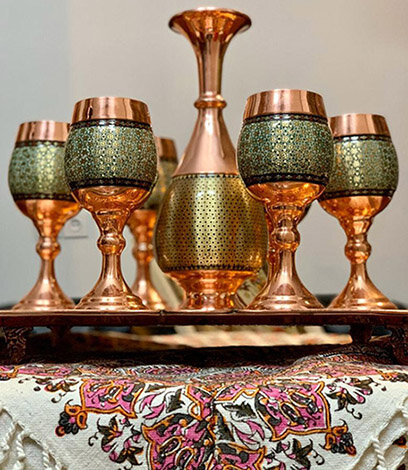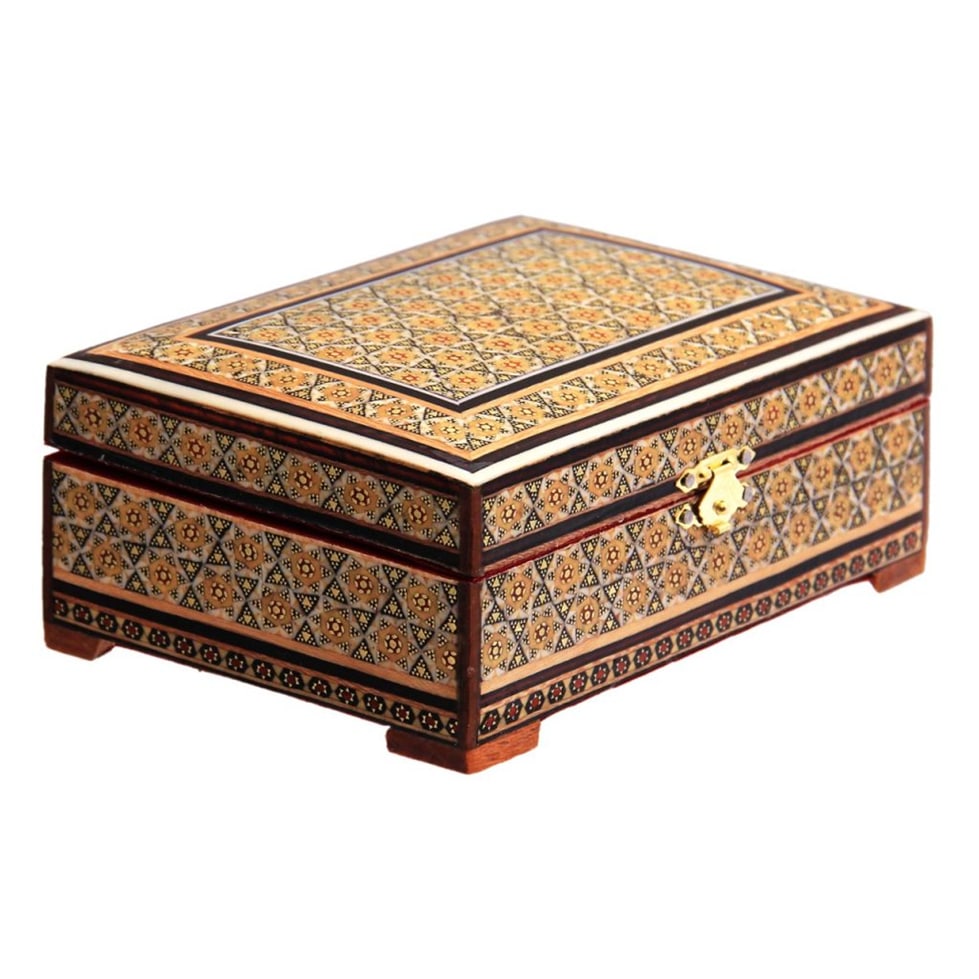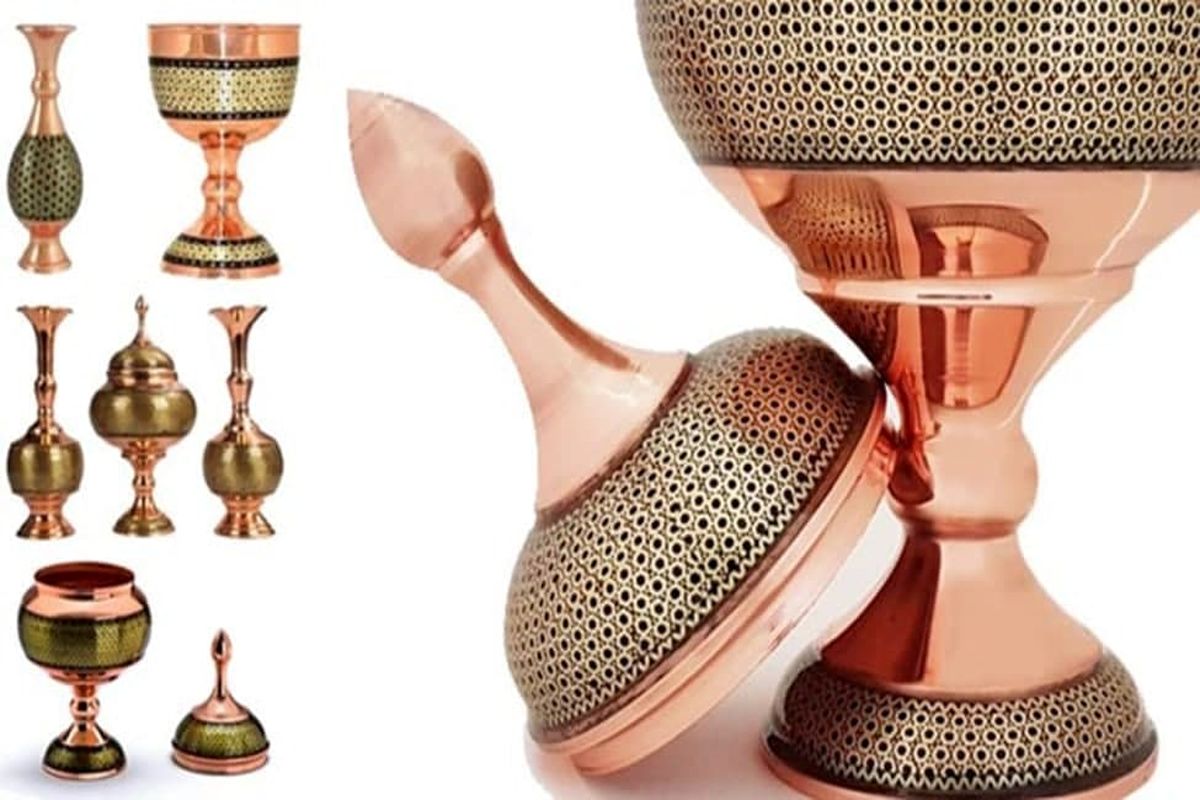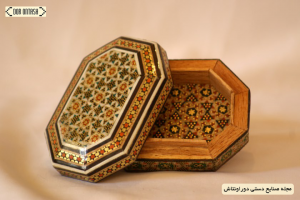Khatam kari is a type of art in which regular polygons in different colors are used. These polygons are placed next to each other in a mosaic based on geometric designs (usually triangular). Finally, a beautiful and eye-catching regular design is created. The triangles used in Khatam are usually made of wood, metal or animal bone . Gold and silver pieces as well as ivory are also used in some inlays . Since the smaller the triangles, the work requires more precision and time, the design of inlay work is better.
Iranian handicrafts can be compared to a beautiful and colorful system, which is one of the bright stars of this galaxy. Shiraz is the birthplace and Isfahan can now be called the base of this noble and outstanding art from the collection of Iranian handicrafts. Inlaying, enameling, turquoise painting, etc., have turned Iran handicrafts into a rainbow of colors, designs, and patterns.
In making a Khatam design, three triangles are needed to make the smallest geometric design , and about four hundred triangles are needed to make the largest geometric design .
Most of the experts in this field consider the city of Shiraz to be the place of birth and marriage of this art . However, due to the interest and respect that the Safavid kings had for art, the art of inlay work, like many other arts, has become popular in the city of Isfahan and has been very well received.
Khatamkari video
Steps and materials for making an exquisite seal
In a general definition, Khatamkari is regular and colorful polygons on the work surface based on creating a geometric or mosaic-like design or a triangle, which in total or creating a regular design creates a stylish, beautiful and eye-catching work.
Khatamkari is one of the most original and beautiful branches of handicrafts in Iran, and its production requires time, precision, and patience in addition to the artist’s taste and artistic vision. According to the opinion of most experts of ancient works, cultural heritage and handicrafts, Shiraz is introduced as the birthplace of this art-craft, but due to the interest and attention of the kings of the Safavid dynasty to this art, Isfahan became the hub of the production and promotion of Khatam Kari and It became the cradle of handicrafts. But there are still some people who believe that Khatam of Shiraz has more elegance and charm than other regions where these works are produced.
The art of inlay work in Iran and the world
Today, Iran is the most important center for the production and distribution of Khatam Kari works . Although this art and craft has become popular in other countries such as India, Iraq, Syria and Palestine ; But the art of women in the mentioned countries like Iran does not have a long history and high elegance. This is the reason why the people of the world attribute Khatam Kari to Iran and are interested in buying it from Iran. Iranian inlays have always been in the first place in international exhibitions and are among the best iran handicrafts.
The best contemporary work of inlay work in the country is the inlay table , which won the gold medal of the Brussels exhibition in 1958.
Shiraz inlay
According to the existing narratives, the origin of Khatamkari is the city of Shiraz, because the oldest works of Khatamkari are found in this city, and the oldest use of the art of Khatamkari is related to the pulpit of the Atiq Mosque in Shiraz , which is more than 1000 years old. There are many evidences that show that the city of Shiraz should be considered as the origin and capital of inlay work in Iran , although this art was transferred to Isfahan during the Safavid period and it was mass produced as a profession in this city.
Shiraz inlay is one of the special arts of this city and because of the special style used in its production, this inlay is distinguished from the inlays of other cities. In fact, Khatam artist has several arts together. Arts such as carpentry, inlay, carving, miniature, etc., and this makes Khatam Shiraz different from other cities.
Khatam Kari of Isfahan
One of the most important and prominent handicraft arts is Isfahan Khatam Kari. The artists and masters of this field carefully and elegantly arrange and put together equilateral pieces using raw materials such as wood, bone and metal, and create lasting and eye-catching works. It is safe to admit that one of the noble and valuable arts of Isfahan is Khatam Kari of this city. These exquisite structures have a beautiful appearance and can be used both as decorative and practical items.
History of Khatam Kari art
Some experts believe that the work of inlaying in Iran started during the rule of the Mughal Ilkhans . During that period, a direct relationship between Iran and China was formed, and one of the results of this relationship is the prevalence of Khatam Kari in Iran. Some other experts believe that Khatam Kari is an authentic Iranian art that was created in Shiraz during the Dillman period and became popular in Isfahan during the Safavid period.
As you know, the Safavid era was one of the golden eras for Iranian art. Since the kings supported artists during this period, and on the other hand, trade relations between Iran and far and near countries were very extensive, the art of inlay work was introduced to all parts of the world and has grown a lot.
It is interesting to know that before Islam came to Iran, in fact, there was an example of Khatam Kari in ancient Iran. In this inlay, single-colored wood is cut in a rectangular shape with four-millimeter sides and mounted on a plate with various designs. In the next step, the wood was fixed on the board by nailing. This method has been customary in our country from Khatam Kari until several centuries after the birth of Islam.

Inlay applications
In the past, inlaying was often seen in the houses of the nobles who could afford the costs of this art; For example, to decorate picture frames, walls and windows. The oldest surviving work of the seal dates back to a thousand years ago, which is the pulpit of the Atiq Mosque in Shiraz.
Today, in some special works, inlay is used to show as much as possible. Due to the relatively reasonable price of inlay, this Iranian art can be found in many Iranian homes, and of course, apart from many applications in decorative and necessary accessories such as: page Chess pieces, jewelry boxes, chocolate containers are also widely used and welcomed outside homes. For example: as a management set for inlay work and office folders, sugar cans, frames, vases, etc. …
One of the basic uses of Khatam Kari dishes is in advertising gifts that are presented by organizations and companies to domestic and foreign guests or even to company employees on various occasions. Among the promotional and organizational gifts of Khatamkari art, we can mention Khatamkari frames, Khatam clocks, Khatam pen holders, Khatam chocolates, desk tools such as Khatamkari napkin holders , etc.

Inlay raw materials
in the manufacture of containers, accessories and parts; We can call silk and lacquer as raw materials in making Khatam. In the production of this eye-catching product, mainly local tools are used, such as: types of walnut (brown), ebony (black), jujube (reddish brown), shamshad (yellow), orange, blue, etc.; All kinds of bones are used, such as elephant ivory, camel bone, horse bone, as well as metal wires made of brass, aluminum, and sometimes silver wire.
Tools needed to make Khatam
Among the necessary and essential tools for inlay handicrafts, we can mention metal clip, sharp file, hammer, pliers, sharp wire saw, sharp triangle, cave, metal meter, fixed ruler and arrowed ruler, gunya and pargar. In the city of Isfahan, Khatamkar Ol first cuts colored wood such as jujube, orange, betel, ebony, etc. in strips with a height of 60 cm to dry.
For high-quality works, they also use bone, so that first they put strips of camel bone in lime water for about 3 months until their color becomes completely white. In the next stage of inlaying, the strips of wood and bone are cut and filed to obtain a clean triangular cross-section, which is called “six” in traditional terms. These strips are placed next to the brass strip, which has become completely similar to wood and bone pieces through ironing, in a colorful and orderly arrangement with a layer of glue.
The prepared lungs are tied with thread so that they are firmly stuck together while drying. This process continues until a complete flower with a height of 60 cm is obtained. After preparing some flowers, they are arranged between two boards side by side, and they are filled with wood glue or serish, and they are made into one piece under the press, which is called “kama”.
Then, the master uses a chainsaw to cut layers between one and one and a half millimeters thick from the surface of the forehead; which is called “lange”. After preparing the infrastructure through carpentry, the inlays are glued on the work area by special adhesives and by heating based on the design, color, shape and dimensions. After puttying, sanding and repairing, the working surface of Khatam is prepared and finally it is covered with a layer of sealer .
The finer and stronger the prepared seal is, and the more it is made of high-quality raw materials, the more valuable it is. In some cases, gold and silver are also used instead of brass. Inlaid objects are sensitive to heat and humidity, and if they are not of good quality, they will rise from the work surface and so-called fall in the vicinity of these elements.

This art has two stages:
1- Khatam making, which includes operations such as design of Khatam, preparation of materials and materials, and cutting of primary materials, mixing and creating flowers, and finally making Qamah (rectangular cube body with an average length of 40 cm, width of 10 cm, and diameter of 3 cm) of wood or inlay) and cutting it and preparing the inlay layer.
2- Khatam work, which includes the design of the foundation, the design of gluing the layers of Khatam on the sub-work, polishing and polishing of the inlay objects.
The method of making Khatam: In Khatam work, wood, bone or metal are cut in the form of al-Qaeda triangle prisms and they are placed together in such a way that the cross section of these single triangles has regular geometric shapes, then with the tip of thin cuts are glued on a thin wooden sheet in a special order and after drying, the sheets are installed on the objects needed for decoration. Wood types are one of the most important materials for inlaying, including jujube
wood , orange, maple, walnut, cake, Tabrizi, boxwood, ebony, betel and batam. All kinds of bones are also used in making Khatam due to their strength and white color, which include camel, horse, cow bones, as well as natural elephant ivory and artificial ivory. In order to make the seal durable and take care of it, colored metals are used in the seal, silver and aluminum are used for white color and brass for yellow color.
In order to prepare the required wood, it should be ensured that it has the right color and texture and does not have knots or cracks. Metals must also have a suitable alloy.

Sealing tool
grater, tang, saw, file, presser, gunya, hammer, gazanbar, cave, press.
Wood inlay materials and materials : betel wood, ebony, jujube, chestnut, azad, begum, orange and boxwood.
Metal: gold or silver wires, copper, brass, aluminum.
Bone: camel or horse leg and arm bone, elephant ivory, synthetic bone.
Green color: This color is made from a mixture of copper shavings and vinegar . The cut bones are poured into a container containing a colored solution and exposed to sunlight for six months . Nowadays, because it is difficult to prepare camel bone, they use orange wood instead of camel bone and to dye it, they use green color for dyeing wool.
Seal lubrication:
Basically, the surface of a seal is oiled for two reasons: the shine of the seal and its protection against moisture, heat and cold. In the past, polishing oil or sandalos (pine tree sap) was used for this. Later, Havilox oil was used, and today they use polyester.

Khatam production steps:
First, they prepare all kinds of wood and bones in different colors and cut them with their special tools to a length of 30 cm and a diameter of 1 to 2.5 mm, and triangles are made from them, and after filing all the sides, they are cut to the desired shape and according to the design. came in and to complete the design, wire wires in the form of triangles were needed, and various steps were taken to prepare them. Then, to make the seal, first the design of the desired shape was drawn by the master craftsman, and these triangles were made of wood, bone and The metal pieces are put together by the artist’s skillful and masterful hands and glued together with a thread, and they are tightened with a thread, which makes the so-called “blade”, after a few hours, the threads are opened and the sides of the file design and put four of the made blades together and glue them together again, which results in “Toglu”.The next stage, which is known as “Gol Pichi”, is made by means of a round wire that is prepared in a regular hexagonal shape, and it is called “Shamse”, six wires are attached around each side by a thread and tied with a strong thread. and the result is a star design, these designs are repeated until they are based on the required design and then placed under pressure and with several stages of cutting and gluing very thin layers of wood around that design First, a seal is created, and all these steps from the beginning until now include more than 400 work steps.
Characteristics of a high-quality inlay:
the work surface is smooth and there is no empty place in the inlay.
The uniformity of the color and materials used in the construction of Khatam,
no change in the color and shape
of the restoration works and putty works should not be evident on the work surface.
All the flowers and shapes on the work surface and the angles and sides
are accurate and the engineering of the basis and structure of the design is that all the dimensions are identical, similar and the same size. It doesn’t exist and it destroys the whole design, that’s why an inlay artist must also be a master carpenter.
The coloring and covering of the product must be skillful and without any defects.
The smaller the patterns and triangles are, the higher the quality and value of the work.

The works of inlaying in different periods
of Safavid era is the most brilliant period of inlaying in Iran. The tomb box of Imamzadeh Seyyed Ala’ddin Hossein, the son of Imam Musa bin Jafar (a.s.) in Shiraz and in the pair of seals of that tomb, which are 400 to 450 years old. Khatam mirror frame which was made in 1124 AH. It was built in Kerman and is part of the private collection of the late Mohammad Hossein Sani Khatam. The shrine box of Hazrat Musa bin Jafar (a.s.) and Imam Javad (a.s.) in Samarra, as well as the tombstone box of Narges Khatun, the beloved mother of Hazrat Hojjatullah (a.s.) in Samarra, which was built during the time of Shah Sultan Hossein Safavi with the help of Ustad Jafar. Khatam masterpieces of that era.
During the Qajar era, it is the entrance to the treasury and shrine of Hazrat Abd al-Azim (AS) and the entrance to the Museum of Ancient Iran.
During the Pahlavi period, the construction of the chests of Hazrat Muslim bin Aqeel (a.s.), Hazrat Abdul Azim (a.s.), Hazrat Shahcheragh (a.s.), and Imamzade Seyyed Mir Mohammad (a.s.).



